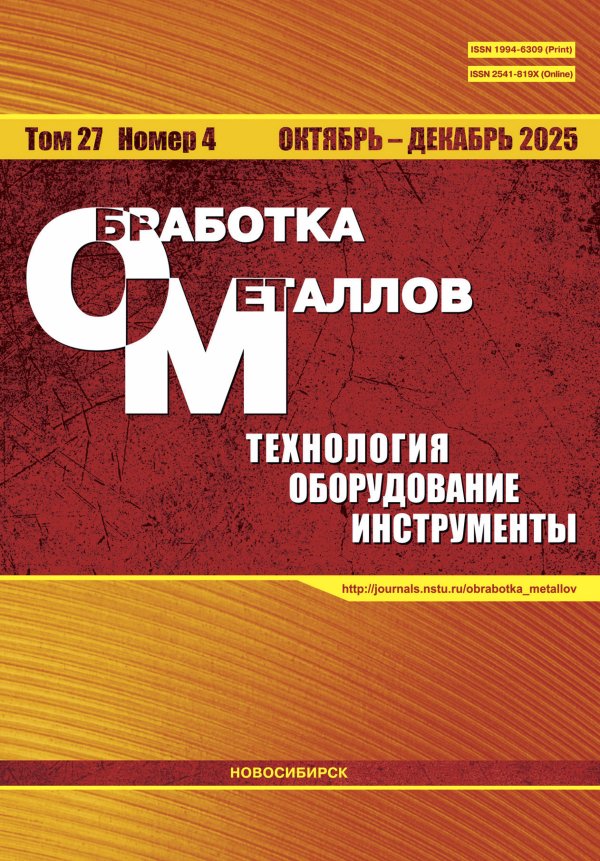Экспериментальное исследование взаимосвязи виброакустических параметров процесса шлифования с показателями макронеровности обработанной поверхности
- Авторы: Ардашев Д.В.1, Жуков А.С.1
-
Учреждения:
- Выпуск: Том 23, № 3 (2021)
- Страницы: 6-19
- Раздел: ТЕХНОЛОГИЯ
- URL: https://journal-vniispk.ru/1994-6309/article/view/301946
- DOI: https://doi.org/10.17212/1994-6309-2021-23.3-6-19
- ID: 301946
Цитировать
Аннотация
Об авторах
Д. В. Ардашев
Email: ardashevdv@susu.ru
доктор техн. наук, доцент, Южно-Уральский государственный университет, пр. Ленина, 76, г. Челябинск, 454080, Россия, ardashevdv@susu.ru
А. С. Жуков
Email: 89127773160@mail.ru
магистрант, Южно-Уральский государственный университет, пр. Ленина, 76, г. Челябинск, 454080, Россия, 89127773160@mail.ru
Список литературы
- Evolution of surface roughness in grinding and its relationship with the dressing parameters and the radial wear / P. Puerto, R. Fernández, J. Madariaga, J. Arana, I. Gallego // Procedia Engineering. – 2013. – Vol. 63. – P. 174–182. – doi: 10.1016/j.proeng.2013.08.181.
- A unified approach towards performance monitoring and condition-based maintenance in grinding machines / Muhammad Ahmer, Par Marklund, Martin Gustafsson, Kim Berglund // Procedia CIRP. – 2020. – Vol. 93. – P. 1388–1393. – doi: 10.1016/j.procir.2020.04.094.
- Taewan Lee E., Fan Z., Sencer B. Real-time grinding wheel condition monitoring using linear imaging // Procedia Manufacturing. – 2020. – Vol. 49. – P. 139–143. – doi: 10.1016/j.promfg.2020.07.009.
- Игнатьев А.А., Коновалов В.В., Козлов Д.В. Определение периодичности правки шлифовального круга по виброакустическим колебаниям // Вестник Саратовского государственного технического. – 2014. – № 1 (74). – С. 71–74.
- Захезин А.М., Малышева Т.В. Определение износа шлифовального круга по параметрам вибрации станка // Вестник ЮУрГУ. Машиностроение. – 2007. – № 11. – С. 48–53.
- In-process characterization of surface finish in cylindrical grinding process using vibration and power signals / S. Mahata, P. Shakya, N.R. Babu, P.K. Prakasam // Procedia CIRP. – 2020. – Vol. 88. – P. 335–340. – doi: 10.1016/j.procir.2020.05.058.
- A novel approach to roundness generation analysis in centerless through-feed grinding in consider of decisive parameters of grinding gap by use of 3D kinematic simulation / M.H. Otaghvar, B. Hahn, H. Werner, H. Omiditabrizi, D. Bahre // Procedia CIRP. – 2018. – Vol. 77. – P. 247–250. – doi: 10.1016/j.procir.2018.09.007.
- Optimization of centerless through-feed grinding using 3D kinematic simulation / M.H. Otaghvar, B. Hahn, H. Werner, H. Omiditabrizi, D. Bahre // Procedia CIRP. – 2019. – Vol. 79. – P. 308–312. – doi: 10.1016/j.procir.2019.02.072.
- Abrasion monitoring and automatic chatter detection in cylindrical plunge grinding / M. Ahrens, R. Fischer, M. Dagen, B. Denkena, T. Ortmaier // Procedia CIRP. – 2013. – Vol. 8. – P. 374–378. – doi: 10.1016/j.procir.2013.06.119.
- Viitala R. Minimizing the bearing inner ring roundness error with installation shaft 3D grinding to reduce rotor subcritical response // CIRP Journal of Manufacturing Science and Technology. – 2020. – Vol. 30. – P. 140–148. – doi: 10.1016/j.cirpj.2020.05.002.
- An active damping method for chatter vibration in plunge grinding using electromagnetic actuators / M. Ahrens, M. Dagen, B. Denkena, T. Ortmaier // Procedia CIRP. – 2016. – Vol. 46. – P. 197–200. – doi: 10.1016/j.procir.2016.03.200.
- Estimation of dynamic grinding wheel wear in plunge grinding / M. Ahrens, J. Damm, M. Dagen, B. Denkena, T. Ortmaier // Procedia CIRP. – 2017. – Vol. 58. – P. 422–427. – doi: 10.1016/j.procir.2017.03.247.
- Dyakonov A.A., Ardashev D.V. Prediction of blunting area of abrasive grains on a grinding wheel // Journal of Manufacturing Science and Engineering. – 2017. – Vol. 139 (12). – Art. 121004.
- Гурьянихин В.Ф., Аринин Д.В. Влияние режимов шлифования на интенсивность акустического сигнала и показатели процесса круглого наружного врезного шлифования // Вестник Ульяновского государственного технического университета. – 2000. – № 4. – С. 79–83.
- Гурьянихин В.Ф., Агафонов В.В., Панков А.А. Управление процессом круглого наружного врезного шлифования с использованием акустического сигнала // СТИН. – 2009. – № 2. – С. 35–40.
- Лурье Г.Б. Шлифование металлов. – М.: Машиностроение, 1969. – 172 с.
- Лурье Г.Б. Вибрации при шлифовании // Станки и инструмент. – 1959. – № 1. – С. 15–17.
- Лурье Г.Б. Автоколебания при шлифовании // Абразивы. – М.: ЦБТИ, 1961. – Вып. 27. – С. 78–83.
- Лоповок Т.С. Волнистость поверхности и ее измерение. – М.: Изд-во стандартов, 1973. – 184 с.
- Raja J., Muralikrishnan B., Fu S. Recent advances in separation of roughness, waviness and form // Precision Engineering. – 2002. – Vol. 26, iss. 2. – P. 222–235. – doi: 10.1016/S0141-6359(02)00103-4.
- Молотников В.Я. Техническая механика: учебное пособие. – СПб.: Лань, 2017. – 476 с.
- Режимы резания на работы, выполняемые на шлифовальных и доводочных станках с ручным управлением и полуавтоматах: справочник / Д.В. Ардашев, Д.Е. Анельчик, Г.И. Буторин, А.А. Дьяконов. – Челябинск: Атоксо, 2007. – 384 с.
Дополнительные файлы







